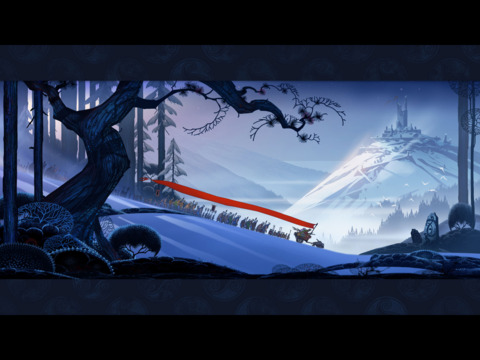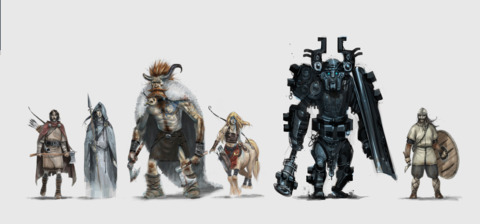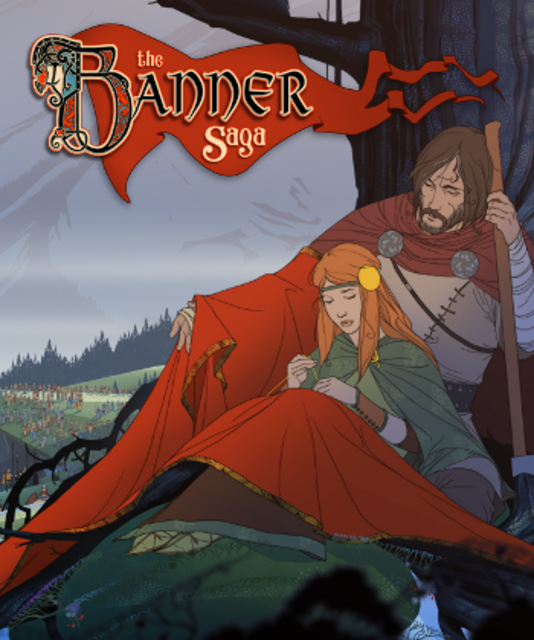So Close, Still Far: A Classic in the Making

Like the game to which it’s attached, this review is largely a graveyard. Though you won’t find Vikings, varl and caravan buried here, only other, lesser reviews. What a hard time I had putting my thoughts to paper! The Banner Saga isn’t a long game, nor is it an especially complex or controversial release. So what’s with my confusion and hesitation? Simply put, this game challenges a lot of basic, but very important game standards: decision making and tactics are old, old hats even in game years, and The Banner Saga has lots of ideas as far as these two branches are concerned. How you react to them, and ultimately how much you enjoy the game, will depend very much on where you sit versus the developer on these topics. Some of us can bend our tastes or flex understanding to get past systems we just don’t like. Some of us can’t. I seem to be born of both these somes, and thus doomed to a life in the middle. One half wanted nothing more than to slam this game for all its faults; the other half loves it for those very warts.
The story of the Banner Saga finds you playing a few different characters, but there are two main leaders you swap between at the game’s will. Both are in charge of different caravans, and both have access to different heroes. The caravan comes in to play in the game’s overworld: you see your caravan, made up of Varl, fighters and clansman, walking across the screen, a giant banner as long as your caravan flowing above them. As you walk to your destination you will be interrupted periodically, either by a town, the enemy, the environment, or a situation within your caravan. During these interruptions you will have to make decisions which will have serious ramifications on your caravan and your heroes. Now, when I see serious I mean morally serious, not gameplay significant, and herein lies one of the Banner Saga conundrums. Your heroes are the pawns you control in the game’s tactical segments; most are handed to you by the game, others can be gained (or missed, or killed) depending on the decisions you make in the caravan travel segments. Now, these heroes and the caravan are inexorably linked, it’s true, but the value of the link is dubious. The basic synergy of the game is as follows: depending on your choices in the game, you will gain Clansmen (worthless civilians who can’t help in battle but eat your food; often picked up due to moral goodness), Varl (massive, dangerous horned giants) and Fighters (humans soldiers). The number you have in each group does not affect your heroes. In fact, it doesn’t affect anything, story or gameplay-wise. Separate to these groups you have rations. You spend 1 ration per day, regardless of how large your caravan is. Time passes automatically as you move across the overworld map, and days go by quite fast. The supposed “catch” is that Renown, the currency you use to buy rations, is also the currency you use to upgrade your heroes. The great tactical failing of The Banner Saga is that rations are the only part of the Caravan that matter, because only the availability of rations affects your caravan morale, and morale, in turn, is the only aspect of the caravan which actually affects battle. But why is that a failing? Because morale, on any difficulty, is largely unimportant.
The tactical element of the game takes place whenever a caravan interruption leads to battle. These can be as straightforward as walking straight into the enemy on the map and just having to fight them, to more complex in-town scenarios where you can choose to flee, face the enemy, and so on. Battle takes place on maps roughly 16 by 16 tiles, though this changes throughout the game. You place up to 6 heroes from your pool on the board, and hit fight to get going. Now if you’ve played any SRPG in the last few years you’ve played something like Banner Saga. The unique quirk it has is the combination of Health Points and Damage into one stat: Strength. The other majorly important stat is Armor. Together, Strength and Armor make up a unit’s general power. Because Strength can only be applied to damage Strength, and Armor can only be damaged by another stat called Armor Break, the game very quickly introduces a number of interesting ways to defeat foes. On the player side of things, all classes are very interesting and their unique abilities vary wildly. Choosing when to attack Armor, and when to attack Strength becomes the pillar of the gameplay. Combine this with tile positioning, which is exceptionally important in Banner Saga, and turn order, which is even more important (and maybe too much so) and you’ve got a very fun fighting system. Unfortunately, it was more fun in the Banner Saga: Factions, the free-to-play, multiplayer PvP predecessor of sorts to this game.
In Factions, all players had access to the same classes, and you had to match power (an average of the heroes’ levels) to fight. Both Banner Saga games have identical systems. Turn order works in a very straightforward way. You go, then the enemy goes. Once one side has only one unit left, the game turns to pillage mode, where all your team goes in a row and then the enemy goes once. What this means is that when your team, or the enemy’s team, is reduced to two or three heroes, those heroes will get a lot of turns in a short time. This can completely reverse the tide of battle. In the multiplayer this was an incredible design because it meant that the fight was never really over until you got to pillage mode. If you got destroyed in the first few rounds, you could always stage a comeback. Having two characters alternate turns is an incredible advantage versus having to manage six because you can take multiple turns attacking a character who won’t move for another dozen turns. Why doesn’t this work in the single player? Shortly: balance. There’s no power matching mechanic at work in the single player, and the game certainly isn’t doing any on the fly re-rolling to match its enemies with characters you may have poured renown into. For example in multiplayer no one could have more than two Varl on a team, regardless of power. In singleplayer you can have 6. So what happens is that you’ll end up completely steamrolling a group of enemies, then wait around the excruciating last moments of battle as the remaining enemies take turn after turn, sometimes actually killing a hero through sheer attrition. It becomes a disadvantage to even take 6 people into battle. The game seems to know this, as you are often outnumbered in battle, which seems like a disadvantage, but, like I mentioned – this is a deceptive system. In a multiplayer PvP, this was a fair, even-handed system which kept every battle interesting to the last hero. In the singleplayer either you will lose heroes to an eye-rolling series of attacks or you will you won’t, but in either case the last third of most battles is a real drag. I strongly, strongly believe that in the singleplayer pillage mode should have been activated once two enemies were left, not one. It’s such an egregious problem I think they will address it either in a patch or with the next game. In comparison to Factions the only other tactical downside is that the enemy has a paltry number of classes, one of which is introduced far too late in the game. While players of Factions will be very excited to try out the new classes like the Hunter and Spearman, they’ll likely find the simpler enemies disappointing. The Dredge, the villains of this tale, are stone golems with little personality or visual flair to distinguish them, unlike the humans and Varl who make up the caravan.

Let’s pull back a little from the tactical view now and see how it interfaces with the caravan. When you are interrupted by a battle chance, you will have the choice to of how to approach the enemy. It always works as follows: do you (literally you, the player) want to face the enemies on the tactical map? Or do you want to sacrifice Varl, Fighters and Clansman to skip the fight? Or perhaps you go 50-50, sacrifice some of your caravan, and thus not fight as tough a battle. Now, I mentioned earlier that only rations affect caravan morale, and only morale affects battle. Every character has a Willpower stat, and an Exertion stat. Willpower is a modifier you can add to nearly anything: your Armour Break, your Strength, how far you can move, and the damage of your special ability. Exertion dictates how much Willpower you can use at once. For example, Eirik has a Willpower of 6 and an Exertion of 2. This means he starts with a pool of 6 Willpower. When he moves, he can add 2 willpower to move 2 tiles further; or he could add 2 to his Armour Break of 1, and do 3 Armour Break damage. Morale then, is a modifier which affects everyone’s Willpower. If you have a high morale, you will get +1 to all heroes Willpower. If you have low morale, that is -1. You can down as far as -2 and as high as +2. At first blush, this seems significant. Willpower will often save the day for you by giving you that 1 extra damage you needed, or move one space further when you have to. So where’s the problem? Ultimately, Exertion is far more important than Willpower. How? Because low morale never punishes you so far that you lose all Willpower, you will always start with some. Add to this the fact that you regain Willpower when you rest, when you kill an enemy, when you buy/equip items which give bonus Willpower under certain conditions, and finally some classes have abilities which give Willpower to others and voila – you’ve got yourself a useless stat! So long as you have some points in exertion, you’ll always find a way to use Willpower when you need it. In the long run, this means that morale doesn’t matter, which in turn means rations don’t matter, which in turn means the caravan doesn’t matter. So when you get to those decision points that ask you what you want to do, you will know the optimal choice is to fight fight fight. This gives you the most renown, and leaves the most of your caravan alive (high morale). It’s funny when you think about it, because the game seems to be hoping you will get bored of battle after battle and just sacrifice some of the caravan to move forward. In fact taking every battle head on kind of throws off the balance of the game in that you end up with tons of renown, so neither leveling up nor purchasing rations becomes an issue.
The ultimate truth is that the entire caravan portion of the game is a veneer of importance so far as combat is concerned. It is, however, on its own, an interesting and well told story, if not a little generic in its end of the world designs. And there’s a saving grace. You, the player – can choose to make the caravan matter. In ye old days we called it roleplaying. And keep in mind: though your clansmen, Varl and Fighters number don’t matter, and though it’s totally OK to spend all your renown on upgrading Heroes rather than buying pointless rations just to keep morale high – your Heroes lives will be at stake as your caravan moves on. Some dialogue decisions can and will put them to the sword. Again this brings up some painful issues in the game’s design. Sometimes you will be asked to choose between a Hero and your caravan’s safety. But since the caravan doesn’t matter, will you choose it? It’s worth noting that as grey as the game wants to be with its doom and gloom and nothing-ever-going-right tale, there is an optimal path. Heroes can be saved if you know which choice to pick. This will irk some players a lot undoubtedly, as it irked me the first time through the game. Choices will employ some game logic here and there, so if you pay attention to the lore and characters you will come out ahead in places, but these are few and far between in the grand scheme of things. Most decisions are intentionally very opaque, and so decidedly different than what you might used to from series like Mass Effect, Dragon Age and Fallout. This leaves a good reason to replay the game (because you really don't know which decision leads to what), but the first time through may leave a sour taste in your mouth as it did mine. When everything feels random and out of your control, it becomes easy to not care, and to just check out, emotionally. Now and then you will engage in a battle where life and death is on the line rather than just a short-term injury, and I found myself wishing the whole game had taken this permadeath approach a-la XCOM. But the longer I played and especially as I replayed the game, I came to appreciate the lack of control I had over the story. If you can approach the game with the mentality BisonHero imparted on me, you can enjoy the game long before beating it: just play the game. Let your morality steer the caravan and see what path that leads you down. Forget than an optimal route exists.
Now, I left this last talking point to the end because it’s been said to death and I wanted to end on a really high note, and here it is: The Banner Saga is one of the best looking games of all time, and due to its classic style, will remain that way. Forever. It is among the pinnacle achievements of 2D game art. If the gameplay matched the excellence of the visuals your PC would melt. ‘nuff said.
As flawed as it may be in its execution of caravan importance and inferior as it may be, tactically, to Factions, The Banner Saga will still give you plenty of tense, exciting combat, and many “Yes! I can’t believe it!” moments. The strength of such a simple system (Armor and Strength) is that what’s happening is so easy to read you’re rarely taken out of the moment to consider the math at play, which is a tremendous achievement in the genre; keeping in mind the replayability of the game and its mindblowing art, it’s hard not to recommend Banner Saga to fans of SRPGs (at any level) and classic animation. Just know that there will be some bumps along the road and you’ll have to put some work in to make the game shine like it can. While it’s not quite a classic, Stoic has at least proved that The Banner Saga could rise to be one.
